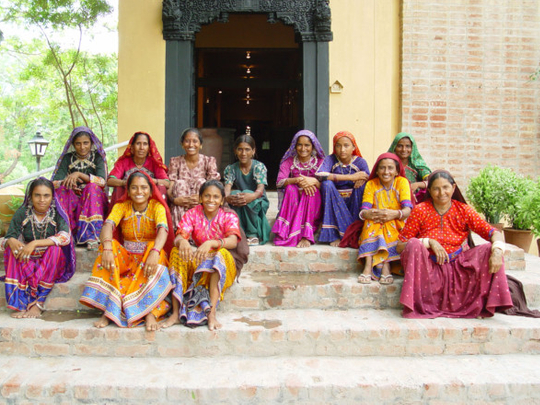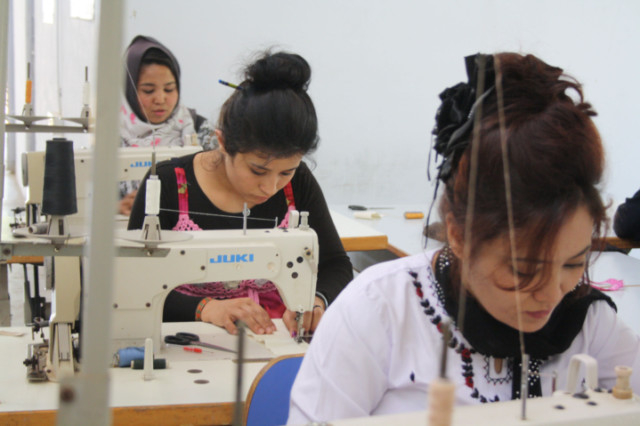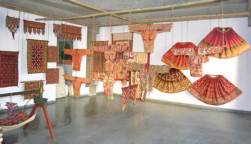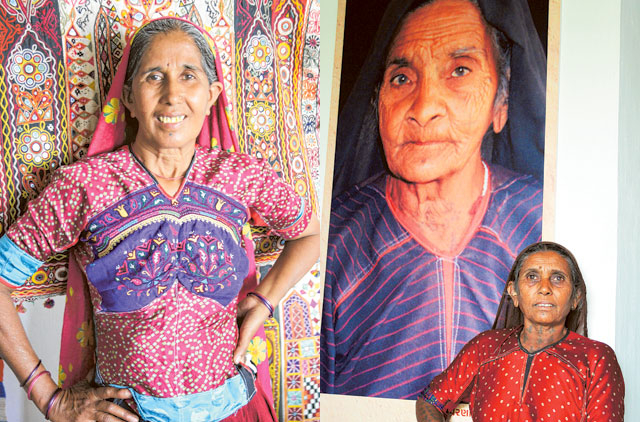
Gauri had inherited traditional embroidery skills from her mother and grandmother. Married at 17, life did not change for her at her in-laws place. She continued to walk kilometres to fetch drinking water and looked for sundry jobs to add to the family income.
Migrating from one place to another in Saurashtra region of Ahmedabad, Gujarat, one day she came across Sewa (Self-Employed Women’s Association), an NGO that works to ensure employment for women. And life took a drastic change. Gauri says, “I was aware of embroidery works that would be used on clothes to be given away in a daughter’s wedding, but never imagined it could be of commercial interest. So, when Sewa offered me decent remuneration for the craft I knew, I was amused and awed.”
After getting training from experts at Sewa, she grasped the market trends and used threads accordingly. Today, she is an envious example of a globetrotter, who has visited countries such as America, Sweden, Bangladesh and Africa to promote and present the works done by Sewa.
An evolved human being and a part of the administration team of Sewa, she trains young women artisans associated with it and also spreads awareness about girls’ education and marriage.
She informs, “In our community, people marry off their daughters at an early age, without giving them proper education. But I did not allow this to happen to my daughter and [got her] married at the age of 22 after giving her proper education. Earlier, I never had a say in family matters, but after I became self-reliant, the attitude of others changed towards me. Everyone in the family not only respects me, but also consults me before taking any important decision.”
Recipient of the Kamala Chattopadhyay Award, which she received recently, Gauri states proudly, “I had the skills, but honed them with the efforts of Sewa. My holistic contribution towards crafts is that I not only try to excel in embroidery work, but at the same time guide other women, so that they too can earn well. The award has got me recognition, which inspires me to do much more for society.”
The NGO has also changed the way Joni, Rani, Ganga, Leela, Nauri, Jamu and several thousand other women across the country think and react to situations after coming in contact with it.
Sewa is the brainchild of Ela Bhatt, who launched the organisation in 1972. It provides employment whereby workers obtain work, income and food security and makes them self-reliant individuals, both economically and in terms of their decision-making abilities.
The women artisans are involved in producing garments right from the conceptual stage — growing cotton, spinning and creating a fabric, dyeing it with colours made of natural herbs and then stitching them. The kurtas, dupattas, home linen and bags are retailed in stores in New Delhi, Mumbai and Ahmedabad. These are also available in stores in Europe, the US, Australia and Japan.
Bhatt says, “My sole objective was to help poor women emerge from poverty.”
Born in Ahmedabad, 80-year-old Bhatt has served as Sewa’s general secretary from its inception to 1996. Appalled at finding that nearly 94 per cent of India’s women workers were employed in the informal sector and did not have formal rights, she had begun contemplating to take up the issue in the late 1960s.
Sewa was born among the urban poor with the lowliest of workers — the rag pickers — and their attempts to change their working conditions. As their numbers began to grow, the organisation extended its activities into rural areas where the urban poor came from. In a matter of time, rural members far outnumbered their urban counterparts.
Bhatt says, “In the rural women I found the heart of India. The dry deserts of Gujarat were home to some of the most resilient women: the embroidery workers who laboured in their homes, the agricultural workers — marginal farmers and salt farmers. Sewa helped them to form producers’ groups in order to build their own assets, enhanced their capacity to stand firm in the competitive market and enabled them to gain access to healthcare and a better life.”
When Bhatt started out Sewa had only 1,017 members. It became 6,000 in 1982 and 23,000 in 1984. The membership rose by over 700,000 and is 1.9 million in 2014. Believing in transforming the lives of millions of women and their entire families, Sewa was earlier restricted to Gujarat, but over the years has covered 10 states.
Time-to-time, the NGO has come under pressure from men who wanted to join the organisation, since in many cases they work alongside the women in the same occupation and face similar problems. Bhatt says, “Initially, I was open to the idea of men joining our struggles, because I thought they would lend more strength to Sewa. However, it was the women who opposed it emphatically.”
Women felt they would feel inhibited with men around, and domination would create problems and tensions. “An unspoken reason was that the women wanted to keep their earnings and savings private — if not secret — from the men. Coming to think of it, the decision of not accepting men has been a good one, as it has allowed women to explore unfamiliar territories with confidence.
“Sewa is about changing the balance of power in favour of the poor. Self-reliance has been the foundation of our approach, because without self-reliance, there is no power. Because of the decision-making abilities, women have escaped to a large extent from the clutches of the moneylenders, contractors and middlemen. And in the process, their self-esteem has grown,” Bhatt adds.
From the very beginning, when Sewa worked with women, it insisted on ownership assets in the name of the woman when debts were to be repaid and a mortgage was released. Men objected, but came to terms on realising its mission and approach. Sewa was familiar with the psyche of women and their saving pattern. They knew, a woman would never allow mortgaging of the property again and that assets were safe in the hands of a woman, who sees the asset as belonging to the family.
For instance: Joni and her husband were daily wagers. With their combined income, the couple was barely able to support the family. Joni knew the art of embroidery and would sell her work to middlemen with the help of her husband. And then Sewa came into their lives and the family’s transformation began.
Though even now Joniben depends on the same craft, there’s a difference. Today, when she needs the money, she does not have to mortgage her property, knowing that she can instead, take a loan. Her husband has also picked up the skills. So, while he manages the production at home, Joni fulfils her duty as a spearhead leader at Sewa Trade Facilitation Centre (STFC) based in Radanpur village in Patan district. Having travelled around the world attending the giant workshops, Joni caters to the global market and has met fashion gurus to understand the demands of the customers. She shares her experiences with other artisans, which helps make their works commercially viable.
Then there is Kaku. “My story of struggle starts with the days when I had to leave my nine-month-old child behind in the hands of my in-laws in search of casual work. But today I work and earn a livelihood from home and at the same time look after my family. Similarly, my daughter and daughter-in-law can stay with their children and take care of the family, even while they work and earn.”
Rudi had her own tale to tell. “I was good at patchwork, but it had no value and I would get peanuts for my efforts. When Sewa made inroads into my life, I realised the worth of my own work. I never imagined my piece of patchwork could some day be used as a curtain and beautify someone’s living room. Working with Sewa not only helped my family financially, it also put a stop to our migration from place to place every four to eight months.”
Like most village women, Rudi used to stitch clothes, but all products would be for personal use. But now she knows the latest market trends and submits her work according to the needs of the buyers. Also, unlike before, when women were not allowed to move out even in groups, the mindset of villagers has changed and she has no inhibitions venturing out alone. On her own, Rudi travels to Delhi, Mumbai and other cities.
Change is happening all the time in the lives of Sewa women. They have become aware that poverty is not their destiny and they have every right to mould their lives. Women, old and young, are working and managing their homes with equal efficacy. Most have an identity and an address, a bank account, an insurance policy and a pension plan.
For charting out new territories for women, Bhatt, the founder of Sewa, has won several national and international awards, including the Ramon Magsaysay (1977), Right Livelihood (1984) and the Padma Bhushan (1986).
Due to her relentless work, the NGO is known not just as an organisation, but a movement — with women as leaders. Bhatt has, meanwhile, handed over the reins of Sewa to Reema Nanavaty, who joined it in 1999.
An Indian Administrative Services (IAS) officer, Nanavaty had quit the service and joined Sewa to help women artisans in the informal sector. She was recently bestowed with the Padma Shri for her contribution in social work.
Asked how women work when they are too old to embroider, she responds: “Contrary to urbanites, rural women are much more healthier. But Sewa does not ditch them when they are old. We believe that they should also become managers and owners, so over a period of time, several artisans become team leaders. Then they just need to assign work to others and visit different villages and play different roles. Many are sent to various states and countries and organise artisans and share their own experiences with the younger lot.
“At Sewa, women have a sense of belonging and treat it as their own organisation. That is the reason we have been able to work with all our neighbouring countries — Afghanistan, Pakistan, Nepal, Bhutan, Sri Lanka, Bangladesh and Maldives. Besides that we get requests from several states in India to visit them and share the Sewa module.”
Nanavaty explains how women in many states suffer hardships. “The artisans of today have battled many calamities including disasters and drought for a very long time. With no water, agriculture or employment, people were left with no option but to migrate. It is in these conditions that STFC realised the dream of alternate employment and the life beyond survival.”
It’s a dream that has become embroiled into reality, which affects many lives in Gujarat. Born out of the persistent attempts of the energetic women, Sewa is seeing a surge of younger generation coming to work at its centres.
Focusing on the works undertaken by the women, Nanavaty elaborates, “The first and foremost for any artisan is recognition. She is not seen as someone’s daughter, sister or daughter-in-law. Women are respected for their own identity, which brings immense self-respect. Their morale gets a boost when their skills are recognised and they bag awards. Such appreciation for the crafts and craftswomen is beneficial for the community at large.”
Women in Sewa are ready to face more challenges and the winds of change. Experiencing the power of unity and realising that they must organise to build their own strength, they are going out of their way to spread the mission of Sewa.
Conscious of the fact that millions of women still remain in poverty and are exploited, despite their long hours of hard labour, Nanavaty has, meanwhile, set a goal of taking Sewa’s membership to 2.5 million women within the next couple of years.
Nilima Pathak is a journalist based in New Delhi.
















